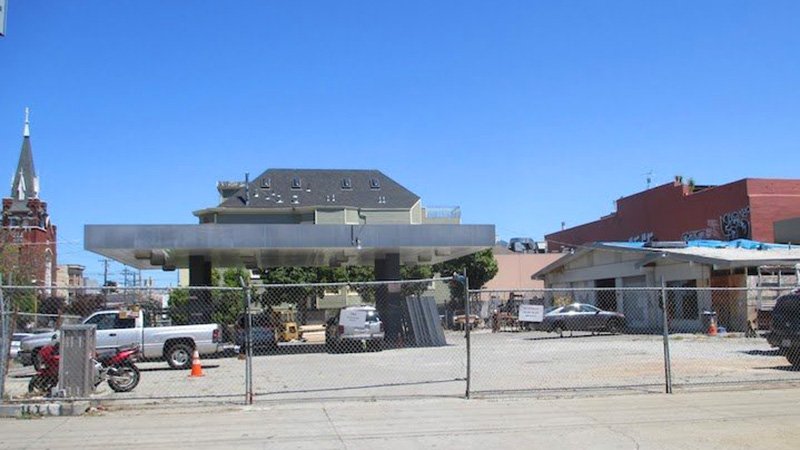Whatever Works (Doing What You Can To Survive the Housing Crisis)
This article was originally published, in slightly different form, on Strong Towns member Johnny Sanphillippo’s blog. Granola Shotgun. It is shared here with permission. All images for this piece were provided by the author.
From big developers to individuals, everyone is doing their best to survive the housing crisis.
Sometimes a story takes a number of years to ripen. And sometimes two or three stories merge in unexpected ways. I just had a moment of convergence when new infill development, wartime migration and sub rosa adaptation all collided.
Back in the 1990s, I used to live across the street from an old gas station. It was still functioning at the time, but some years after I moved, it went dark and became little more than a parking lot. That lasted for over a decade. That’s how long it takes to get approval for new construction in San Francisco. Then one day a fence went up, the gas station building was scraped and a remediation crew went to work decontaminating sixty-odd years of petroleum funk from the soil. Benzene, toluene, ethylbenzene, xylenes, lead, heavy metals, MTBE, ethylene dichloride, naphthalene… Fun stuff.
I like to stop by and chat with the folks who do this kind of work. Evidently, they inject various sugars and fertilizers into the earth to stimulate bacteria that eat the toxic hydrocarbons and break them down into simpler, less troublesome elements. That took a few more years. And then, like a mushroom sprouting, an apartment building went up in a matter of months. The permit process and site preparation cost millions of dollars. Construction during the Covid supply chain period made the building significantly more expensive than it might have been. Radically lower interest rates on the construction loan helped soften the blow, but none of this work is cheap. In the end, demand for new housing is powerful, and the market gobbled up the units the instant they were completed.
Resistance to new buildings like this one comes from all sides. Existing renters saw it as a sure sign of gentrification that would drive up rents in a previously affordable neighborhood and push them out of the city. Existing property owners saw these buildings as too big, too out of place, and too full of people who would induce more traffic congestion and more problems. I always asked how they felt about the old gas station. Was that a cherished community institution?
Fast-forward to this week, when I helped a Ukrainian couple move into their new accommodations in the building. They arrived from Europe six months ago and were sponsored by my good friends. They were initially provided with a free space to crash so they had time to secure legal documents, find work and establish themselves in a new country.
I’ve also been busy sponsoring Ukrainians displaced by the war, so I was already on board with the whole integration process. I reached out to the usual suspects and brokered some free furniture for them.
The sofa was donated by a friend who was ready to upgrade. He graciously helped deliver it to the building. And that’s where the sub rosa thing comes in.
This particular friend has spent his life carefully selecting properties — sometimes rented, sometimes owned — that were considered undesirable by most people. But they suit his needs perfectly. These properties always come at a deep discount that frees him to work as little as possible at a traditional job for income. This gives him the time he values more than money or a prestigious address to pursue his true passions.
He currently lives in a long-defunct shopfront that he’s scrubbed clean, painted, organized and strategically upgraded. He fitted the back office with a kitchen (minus a stove), second-hand fixtures and appliances he scavenged for cheap. For something that only cost a few hundred dollars, I think it looks quite respectable. I especially love the way he fitted mirrors to the fridge to transform it from a scratch-and-dent unit to something with a bit of sparkle.
His neighbors love him, he causes no problems, and he pays all his bills by working two days a week. This is the other way new living space is carved out of a wildly overpriced city. It works because it doesn’t exist on paper and the authorities haven’t yet discovered all the ways it violates a thousand cherished regulations.
I stopped caring about “solutions” a long time ago. There are no official remedies for much of anything these days. Our institutions are rigid and dysfunctional. The culture is divided. Meanwhile, individuals do what they can. I’ve made peace with that.
























